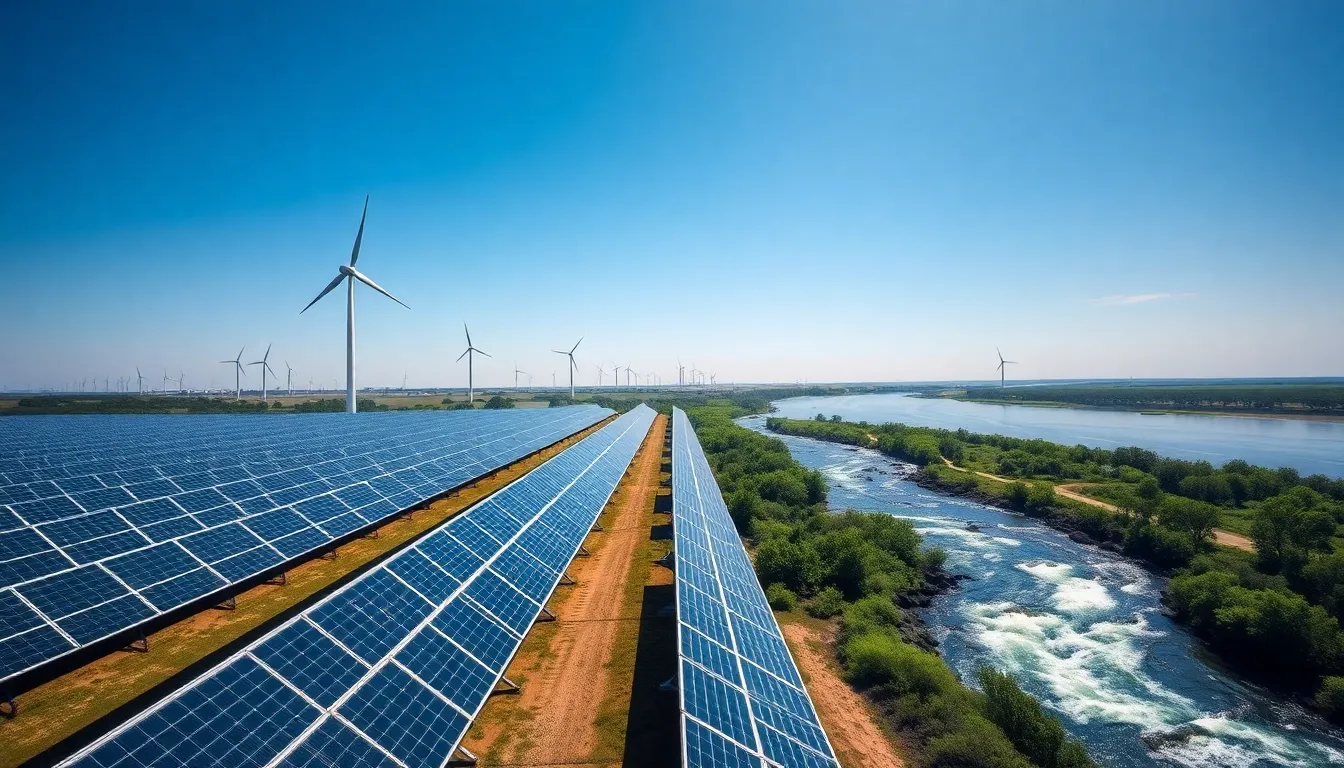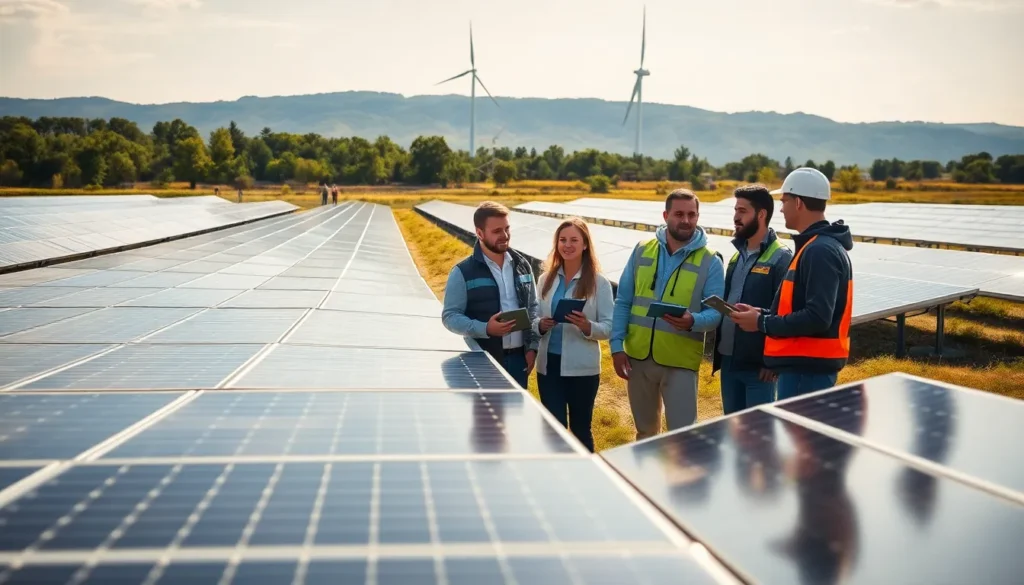In a world increasingly aware of climate change and environmental degradation, renewable energy technology stands at the forefront of the global energy revolution. This innovative sector harnesses natural resources like sunlight, wind, and water to generate clean power, offering sustainable alternatives to fossil fuels. As nations strive to reduce carbon footprints and meet stringent energy demands, the advancements in renewable technologies are more crucial than ever.
From solar panels that capture sunlight to wind turbines that convert breezes into electricity, these technologies are reshaping how energy is produced and consumed. With ongoing research and development, the potential for increased efficiency and reduced costs makes renewable energy not just a trend but a necessity for a sustainable future. As we delve deeper into this topic, the impact of renewable energy technology on economies, environments, and everyday lives becomes increasingly clear.
Table of Contents
ToggleOverview Of Renewable Energy Technology
Renewable energy technology encompasses various systems designed to harness natural resources for clean energy production. These systems include solar power, wind energy, hydropower, geothermal energy, and biomass. Each technology plays a critical role in the transition away from fossil fuels and toward sustainable energy solutions.
Solar Energy
Solar energy technology utilizes photovoltaic cells to convert sunlight into electricity. Solar panels installed on rooftops or solar farms capture sunlight for residential and commercial energy needs. In 2022, solar power accounted for approximately 3% of global electricity generation, with significant potential for growth.
Wind Energy
Wind energy technology employs wind turbines to convert kinetic energy from wind into electricity. Offshore and onshore wind farms generate substantial amounts of energy. By the end of 2022, wind energy contributed around 9% of the world’s electricity, showcasing its importance in the renewable sector.
Hydropower
Hydropower utilizes flowing or falling water to generate electricity. Large dams and small-scale hydro installations harness the kinetic energy of water, providing a consistent energy source. Hydropower represented about 15% of the global electricity supply in 2021, making it the largest source of renewable energy worldwide.
Geothermal Energy
Geothermal energy technology harnesses heat from the Earth’s core for power generation and direct heating applications. Geothermal power plants supply electricity, while geothermal heating systems provide warmth to buildings. This technology plays a vital role in areas with significant volcanic activity, such as Iceland and parts of the United States.
Biomass
Biomass energy technology converts organic materials, such as wood, agricultural crops, and waste, into usable energy forms. Biomass can serve as a substitute for fossil fuels in heat and electricity generation. In 2020, biomass energy contributed about 5% of total U.S. energy consumption, highlighting its potential for reducing greenhouse gas emissions.
Collectively, these renewable energy technologies support a sustainable energy future by reducing reliance on fossil fuels, lowering carbon footprints, and promoting energy security. Continued advancements in efficiency, cost reduction, and storage solutions will further enhance their viability and adoption.
Types Of Renewable Energy Technologies

Several renewable energy technologies play significant roles in transitioning to cleaner energy solutions. Each technology harnesses natural resources to produce sustainable energy.
Solar Energy
Solar energy converts sunlight into electricity using photovoltaic cells or solar thermal systems. Photovoltaic cells generate direct current (DC) electricity that can be converted into alternating current (AC) for residential and commercial use. Global solar capacity reached over 1,000 gigawatts (GW) in 2021, contributing about 3% of worldwide electricity generation. Innovations such as solar tracking systems enhance efficiency by optimizing the angle of solar panels to maximize sunlight exposure.
Wind Energy
Wind energy utilizes turbines to capture wind kinetic energy and convert it into electricity. Wind farms, both onshore and offshore, collectively exceed 700 GW of installed capacity globally as of 2021. Turbines typically operate when wind speeds range from 9 to 55 miles per hour. Advanced turbine designs and predictive maintenance technologies improve reliability and increase energy production. Countries like Denmark and Germany lead in wind energy utilization, aiming for significant carbon reductions.
Hydropower
Hydropower generates electricity from flowing or falling water, making it one of the oldest renewable energy technologies. This sector produces roughly 16% of global electricity and offers a cumulative installed capacity of over 1,300 GW as of 2020. Hydropower systems can be categorized into large-scale dams and small-scale installations. Run-of-river systems minimize environmental impacts by avoiding extensive flooding. Efforts to improve fish passage and water management continue to enhance hydropower’s sustainability.
Biomass
Biomass energy converts organic materials, like plant or animal matter, into usable energy forms, such as heat, electricity, or biofuels. In 2020, biomass contributed about 5% of total U.S. energy consumption. Feedstocks include agricultural residues, wood chips, and dedicated energy crops. Technologies like anaerobic digestion and gasification optimize biomass energy production. Sustainability practices are essential for ensuring that biomass resources do not compromise food production or biodiversity.
Geothermal Energy
Geothermal energy taps into the Earth’s internal heat to generate electricity and provide heating. The global geothermal capacity reached approximately 15 GW in 2021, with major developments in countries like the United States, Indonesia, and the Philippines. Geothermal plants typically utilize steam from high-temperature reservoirs to drive turbines. Enhanced geothermal systems (EGS) aim to expand geothermal potential by improving heat extraction from broader geological formations. Sustainable resource management ensures long-term viability and efficiency in geothermal energy production.
Benefits Of Renewable Energy Technology
Renewable energy technology offers numerous advantages, ranging from environmental benefits to economic gains. Understanding these benefits highlights the critical role renewable energy plays in modern society.
Environmental Impact
Renewable energy technology significantly reduces greenhouse gas emissions. By harnessing natural resources like sunlight and wind, it minimizes air pollution and mitigates climate change effects. For instance, solar and wind installations produce zero emissions during operation, contrasting sharply with fossil fuel systems. This transition leads to cleaner air and healthier ecosystems.
Ecosystem preservation is another advantage. Renewable technologies generate energy without depleting resources or harming wildlife habitats. Wind farms and solar installations coexist with local wildlife when designed thoughtfully, maintaining biodiversity. Additionally, renewable resources like water for hydropower and biomass from organic materials are sustainable, promoting responsible resource management.
Economic Advantages
Renewable energy technology fosters job creation. The sector employed over 11 million people globally in 2018, with numbers expected to rise as renewable industries expand. Jobs range from manufacturing solar panels to installing wind turbines, offering diverse career opportunities.
Cost reduction is another significant advantage. The global average cost of solar photovoltaic systems dropped by 82% between 2010 and 2019, making solar energy increasingly accessible. Wind energy also saw substantial cost declines, contributing to its competitiveness in energy markets. As technologies improve and production scales up, costs will continue to fall, encouraging wider adoption.
Energy independence enhances security. By investing in domestic renewable energy sources, countries can reduce reliance on imported fossil fuels. This transition strengthens energy security, stabilizing local economies and protecting them from global price fluctuations.
Challenges In Implementing Renewable Energy Technology
Implementing renewable energy technology faces various challenges that hinder widespread adoption. These challenges include technological barriers and policy and regulatory issues.
Technological Barriers
Technological barriers significantly impact the deployment of renewable energy technologies. High initial costs for advanced systems, such as solar panels and wind turbines, limit accessibility for many users. Energy storage solutions, essential for managing intermittent power sources, also remain costly and underdeveloped. Grid integration poses another challenge, as existing infrastructures may not efficiently accommodate renewable energy inputs. Furthermore, the need for continuous innovation in efficiency and reliability adds complexity, necessitating ongoing research and development efforts.
Policy and Regulatory Issues
Policy and regulatory issues play a critical role in shaping the renewable energy landscape. Inconsistent regulations across regions create confusion, discouraging investments and slowing project development. Subsidies for fossil fuels often skew the market, undermining competitiveness for renewable technologies. Additionally, lack of supportive policies, such as feed-in tariffs or renewable portfolio standards, hampers growth in the sector. Regulatory hurdles related to permitting and siting projects can also delay timelines and increase costs. Addressing these issues requires concerted efforts from governments and stakeholders to establish a coherent framework that supports renewable energy adoption.
Future Trends In Renewable Energy Technology
Future trends in renewable energy technology focus on enhancing efficiency, reducing costs, and integrating innovative solutions. The advancements in energy storage and smart grid technology play critical roles in achieving sustainable energy goals.
Innovations in Energy Storage
Innovations in energy storage significantly enhance the reliability of renewable energy sources. Lithium-ion batteries dominate the storage market, offering improved energy density and extended lifespans. Emerging technologies, such as solid-state batteries, provide increased safety and faster charging times, potentially revolutionizing energy storage. Flow batteries present scalable options for large-scale applications, balancing energy supply and demand effectively. Moreover, advancements in thermal energy storage systems allow for the capture and storage of excess heat generated by renewable sources, enabling energy to be utilized during peak demand periods. These innovations collectively improve grid stability and support the seamless integration of renewable energy into existing infrastructures.
Smart Grid Technology
Smart grid technology transforms energy distribution and consumption, enhancing the efficiency of renewable energy systems. This technology incorporates sensors, advanced metering, and real-time data analytics, optimizing energy flow and management. Smart grids allow for better communication between energy producers and consumers, facilitating demand response strategies that reduce peak load during high consumption periods. Integrating distributed energy resources, such as rooftop solar panels and electric vehicles, becomes more efficient with smart grids, supporting decentralized energy generation. Enhanced cybersecurity measures ensure that these networks remain resilient against potential threats, reinforcing the reliability of renewable energy sources in the overall energy mix.
The future of renewable energy technology holds immense promise. As advancements continue to emerge the transition to a sustainable energy landscape becomes increasingly feasible. Innovations in solar wind hydropower geothermal and biomass technologies are reshaping how energy is produced and consumed.
With ongoing research and development the efficiency and affordability of these renewable sources will only improve. By overcoming existing challenges through collaborative efforts and supportive policies the potential for a cleaner healthier planet is within reach. Embracing renewable energy isn’t just a choice; it’s a necessity for a sustainable future.








